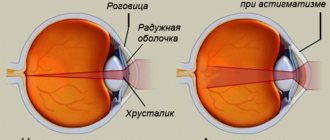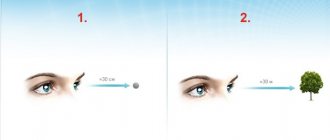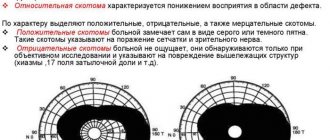Myopia and childbirth
When doctors say that poor vision can affect childbirth, they most often mean myopia (nearsightedness). Myopia is a violation of the focus of vision, in which distance vision deteriorates. Hence the second name of the disease: myopia, since people with myopia see much better up close. There are three degrees of myopia: up to 3 diopters - weak degree; from 3.25 to 6 diopters – average degree; over 6 diopters – strong degree.
If the expectant mother has vision problems, the ophthalmologist often recommends shortening the period of pushing so that the woman in labor does not overexert herself and her vision does not deteriorate.
If myopia is weak or moderate, then childbirth will not affect it in any way. But with high myopia, there is a risk that during childbirth, already poor vision will become even worse. Why? During childbirth, a woman’s entire body experiences extreme stress, including her eyes. And with myopia, the retina (a thin layer of nervous tissue located on the inside of the back of the eyeball) is already thinned and stretched, and under heavy stress it can detach or rupture. In this case, vision can deteriorate significantly.
Pregnancy, childbirth and vision: what are the risks?
Poor visual acuity does not affect pregnancy.
Negative consequences are minimized. To maintain vision, ophthalmologists prescribe biological supplements based on blueberries and carotene.
During the period of bearing a child, the female body is completely rebuilt: hormonal levels change, the structure of the blood changes, and the speed of blood flow decreases.
All these indicators can complicate the course of pregnancy only if the diagnosed pathology progresses.
There are no restrictions on wearing lenses or glasses for a pregnant woman with weak visual apparatus.
During gestation, pathology can be corrected using laser therapy. It can be carried out from the beginning of pregnancy until the 34th week of gestation.
The procedure does not require the use of anesthesia, which means it is absolutely safe for the baby and mother.
As a result of laser therapy, the condition of the retina improves, the sites of detachment and swelling of the optic nerve are coagulated.
Childbirth and eyes
Poor vision during pregnancy can lead to negative consequences during the childbirth period.
This applies only to natural childbirth. To push the baby out of the womb, the woman in labor makes enormous efforts. She has to push, which causes changes in intracranial pressure, abdominal tension and depth of breathing.
Fundus pressure changes and detachment of thin nerve tissue that is tense and stretched may occur.
The consequences can be extremely severe - complete loss of vision in one or both eyes, depending on the degree of myopia.
To prevent the appearance of burst capillaries, you must:
- When pushing, listen to the doctor and midwife;
- Push down, not into the head;
- Don't scream or cry;
- Pull your legs towards your stomach as much as possible;
- Inhale through your nose and exhale through your mouth.
In the postpartum period, the eyes of the woman in labor are examined on the second day, identifying progress as a result of childbirth.
Women often note an improvement in vision, but this is often a short-term phenomenon associated with a change in pressure.
Let's go to the doctor
If an expectant mother has problems with her eyes, then she should visit an ophthalmologist at least 3 times: at the beginning, middle and end of pregnancy. Why so often? It is necessary to monitor the condition of the retina so as not to miss the moment when some changes or even tears appear on it. And this can only be done by regularly seeing a doctor.
At the end of pregnancy, the ophthalmologist gives an opinion on the state of vision and recommends delivery tactics. If the doctor writes that “it is recommended to exclude the period of pushing due to possible damage to the vessels in the retina,” this means that, most likely, a cesarean section will be necessary. If the condition of the retina is normal, then the ophthalmologist will simply write: “There are no contraindications to natural childbirth.” In addition, all vision problems should be discussed with the doctor who will deliver the baby. After all, the ophthalmologist only recommends tactics for their management, and the final decision is still up to the obstetrician-gynecologist.
Don't cut from the shoulder
Once your lenses are wet with tears of joy after the incredible news of motherhood, don't even think about panicking! For now, you differ from expectant mothers with good vision in only one thing: in addition to regular visits to the antenatal clinic, you will have to add frequent visits to the ophthalmologist. One visit every couple of months will be enough for the specialist to draw conclusions based on his observations and, after a few months, give you recommendations on whether or not to have a cesarean section.
Do not forget to notify your obstetrician-gynecologist about vision problems, who must have all the information about the well-being of the expectant mother and understand the risks associated with the appearance of the baby. Poor vision during pregnancy is not a death sentence, but in order to avoid further pathologies, one must not forget about it.
As it will be
In fact, with myopia, retinal pathology is not always present. Even with a high degree of myopia, the condition of the retina can be good. Conversely, changes in the retina can also occur in a person with normal vision.
Many people believe that the presence of myopia is a direct path exclusively to a caesarean section. But that's not true. There is an instruction from the Ministry of Health and Social Development, compiled jointly by ophthalmologists and obstetricians-gynecologists. According to this document, surgical intervention is necessary only for myopia greater than minus 7 diopters. In other cases, it is proposed to act based on the specific situation. This means that when deciding how best for a woman to give birth, the doctor will take into account not only visual acuity, but also the general well-being of the expectant mother, her age, the condition of the retina, and various complications during pregnancy. For example, if high blood pressure, edema and other complications are added to myopia (albeit a weak degree), then a cesarean section cannot be avoided. By the way, now many doctors generally believe that visual acuity should not affect the method of childbirth and you can give birth even at minus 10–12, the main thing is that the retina is in good condition.
What are the dangers of natural childbirth for retinal diseases?
The condition of the retina and fundus of the eye are indicators that have important diagnostic value. If the doctor has not identified pathologies of the retina, then with a high degree of probability he will allow the woman to give birth herself. The presence of pathological changes and other disorders in the retina may be an indication for a planned cesarean section. Since during contractions the muscles of the female body contract intensely, blood begins to circulate more actively through the vessels, and there is a risk of hemorrhages in the eyes and retinal detachment. This is the most dangerous situation and can lead to complete loss of vision. Attempts, during which the tension increases, are reflected even more strongly on the visual organs. If a woman in labor pushes incorrectly, this leads to increased intraocular pressure and increases the risk of retinal detachment.
To avoid dangerous situations during childbirth, the doctor may recommend that a pregnant woman up to 34 weeks undergo laser correction, which will allow her to give birth on her own without fear for her vision.
Natural childbirth
If natural childbirth is allowed, then the most important thing during it is to push correctly. What does it mean? You need to push exclusively in the direction of the perineum. That is, you don’t need to tense your face or close your eyes - it won’t do any good. All effort should go to the perineum. It is the pelvic floor muscles, together with the abdominal muscles, that will help the baby be born. If you strain your face (push with your face), then the child will not get any help, and your strength will be wasted, and your eyes may suffer. Unnecessary strain will cause intraocular pressure to increase, which can cause small blood vessels to burst. With a normal eye condition or with slight myopia, this is not a problem, but with a strong degree of it, bleeding, rupture may occur in the retina, and in the worst case, it will begin to peel off.
What will the birth be like?
Many women worry in advance about what kind of birth they will have and whether a caesarean section will be required. This question interests almost all pregnant women, especially those with vision pathologies. When making a decision, many factors are taken into account, including the woman’s age, health status, vision, etc.
A caesarean section is a complex operation in which an incision is made in the abdominal wall and uterus, through which the unborn child is removed. The health risk is 10-12 times greater than with natural delivery, so it is prescribed in exceptional cases. The procedure is indicated if it is impossible to give birth independently, as well as if there is a danger for mother and child.
Glasses and lenses
Is it possible to give birth with glasses? Is it possible to take them to the birth block? Of course you can, because without glasses many people feel extremely uncomfortable.
It is better to visit the ophthalmologist for the last time shortly before the expected date of birth, when the baby finally takes its position in the uterus. This will allow you to predict the approximate course of labor. In addition, by the end of pregnancy, high blood pressure, swelling and other problems can be added to existing vision problems. Only by summing up all this data, the ophthalmologist makes a conclusion about the possibility or impossibility of natural childbirth.
But whether it is possible to give birth in lenses – even ophthalmologists do not have a clear opinion. On the one hand, there is nothing so bad about wearing lenses during childbirth, because they do sports in the lenses and even sleep in them. But everyone’s lenses are different, and women feel differently in them too. Someone can wear lenses for only one day and must take them off in the evening. Others prefer to wear lenses for a month and feel great with them. Therefore, it is necessary to decide, taking into account each specific situation.
Why is it often recommended to remove lenses during childbirth? If a woman pushes incorrectly, the lenses can further aggravate the eye condition. In addition, if any emergency intervention with anesthesia is required, the lenses will need to be removed. And there may simply not be time for this.
Therefore, if you want to give birth wearing lenses, you need to take a special solution and a container for storing lenses with you to the maternity hospital. And be sure to warn doctors that you are giving birth with lenses.
Pleasant nuances
There are women whose vision after childbirth not only does not deteriorate, but even improves. This happens because vision problems arose as a result of certain disorders in the body - muscle spasms, pinched nerves, congestion. During the birth process, these problems disappear, and as a result, the young mother begins to see everything in a truly new light.
Doctors' attitude towards childbirth among women with vision problems has now changed. People give birth naturally and with high myopia, and after some eye surgeries. If you have any doubts, contact a large ophthalmology clinic; they will definitely know which method of childbirth is best to choose in your situation.
Photo - Lori's photo bank
For what visual problems is a caesarean section prescribed?
There is a wide range of contraindications for vision, in which a woman is prohibited from giving birth herself and undergoes a planned caesarean section.
- Progressive myopia. If vision deteriorates by one or two diopters every year, this is accompanied by thinning of the retina and there is a risk of its detachment.
- Swelling of the optic nerve, which can lead to increased intracranial pressure.
- Retinal detachment or recent surgery for this reason.
- Hemorrhages and disorders in the condition of the fundus.
The final conclusion as to whether a woman can give birth on her own or will have a planned caesarean section is given only by a doctor.











